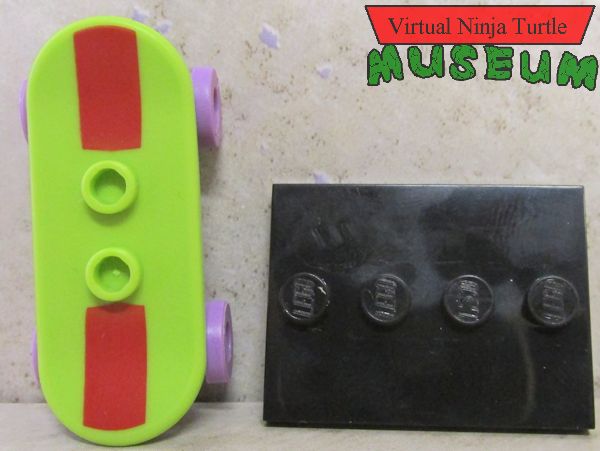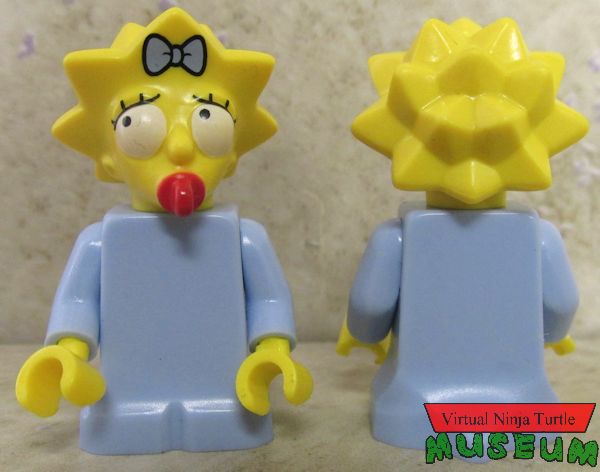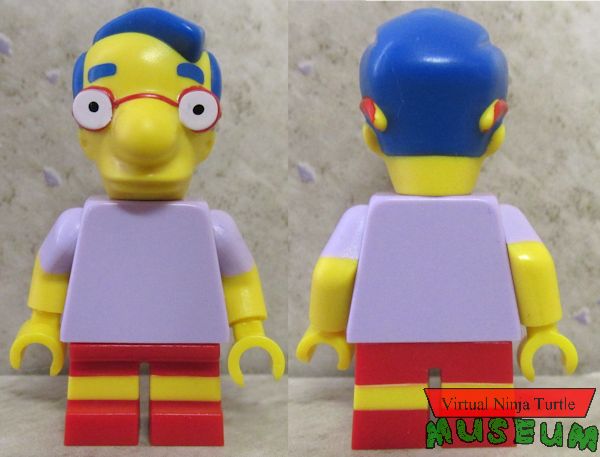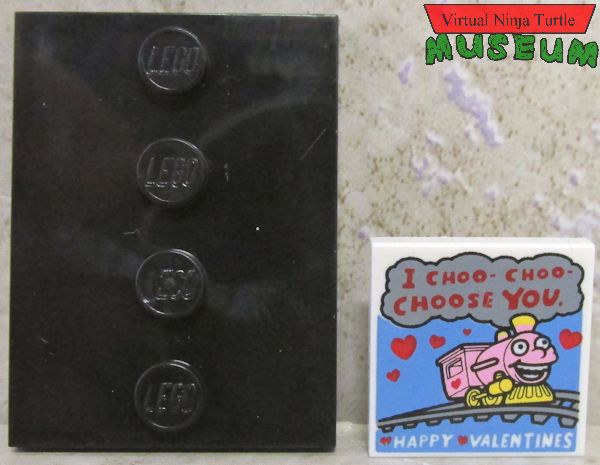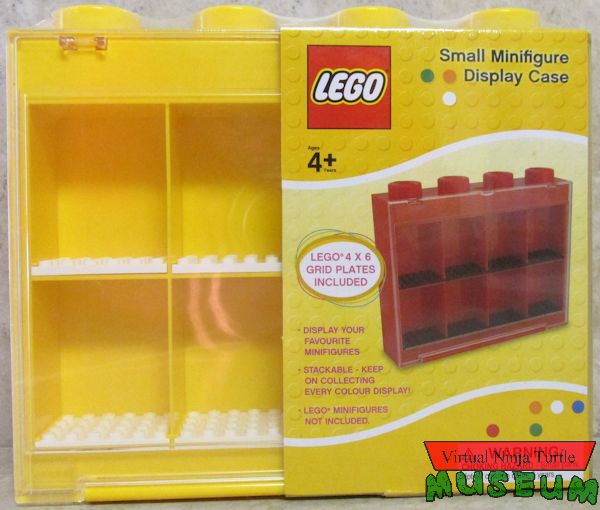Lego Simpsons Minifigures & Minifigure Display Case review

|
Generally when someone suggests combining two properties together, the expectations and hype far outshine the final product. And
when it was announced last fall that The Simpsons and Lego would be working together, I was curious, but not very hopeful. But
when they actually released photos of the Simpsons' house set, my interest was piqued. And when The Simpsons Lego episode aired
two weeks ago, my appetite for some Simpsons Legos was set off. But I don't really have the space for the house playset. And it's
really the characters from The Simpsons that interests me, not the building or even the family car. But Lego was ready for my
yellow plastic fever. They have released a series of The Simpsons themed minifigures which have recently begun showing up in stores.
Still, the annoyance of not knowing which toy you are actually buying due to blind packaging was enough to keep me screaming
"shut up and take my money" in any of the local toy stores. Still, my curiousity and gluttony were strong. So when I found out
there were markings on the packs to allow you to determine which toy was inside, my bank account became $64 lighter and my Ninja Turtle
Lego minifigures had some new, yellow neighbors.
Of course, now that I have a small portion of the population of Springfield in minifigure form, I'll need a home for them. I have been eying the minifigure display cases produced by Lego since the Ninja Turtle Legos were released a year ago. But since they are all sold with building sets, I was hesitent to just display the minifigures and waste the vehicles and the lair playsets that I actually like quite a lot. But with sixteen Springfield residents in need of a new home, this was the perfect time to pick up two of the small display cases. But I'll save my thoughts on them until later.
Packaging - 6/10The Simpsons minifigures are packaged in small mylar bags. The bag has an image of a group of nine of the minifigures adorning the front as well as the minifigures and Lego logos. The back of the bag is covered with the usual legal and safety fine print. Put all of that against a background of Simpsons sky blue with a few clouds, and you get a package that is bright and very much in keeping with The Simpsons license. But I'm still not a fan of blind box/bag packaging in principle and the bag is not enough to show off the contents. But what save it is the display cases in the stores. I have seen both verticle mounted cases to be attached on store endcaps and cases that sit directly on the shelf. But both designs manage to fit large images of all sixteen available minifigures on the display case. It still leaves MOC collectors out of luck, but the display cases were quite effective at attracting my attention and enticing me to buy the figures that I previously thought I was going to pass up. All of those images of the available figures is also incredibly valueable while trying to find the particular figures that you want; but I get to that later.
Sculpting - 8/10Translating a two dimensional cartoon character into a three dimension form can be very tough. Translating one into a highly stylized and yet simplified block figure in a way that allows the character to still be easily recognizable and look great is an incredible challenge. In the Lego episode of The Simpsons, they managed to create versions of the characters that did use the traditional, cyclindrical minifigure head with a few accessory pieces for the various hair styles. That was quite ambitious but they pulled it off well. For the actual minifigure toys, Lego went the slightly safer route and created fully sculpted heads for each of the Simpsons characters. And they look terrific. Still, there is a small part of me that wants to see the characters executed more like they were in the show, closer to a traditional Lego minifigure. But then I remember how the Playmates Blocko figure turned out. So maybe I'll just take what's in front of me and be happy.
Paint - 8/10The paint work for the minifigures turned out very well. All of the sculpted heads have numerous paint applications. And I do not see any quality control issues. Then of course there are the traditional decorations on the minifigure bodies. Given Lego's reputation for quality, I would expect these to be exceptional well done. They are good. I'll give them credit for doing a few creative touches as well such as Bart's slingshot which is on two different pieces which needed to line up perfectly. But there are a great number of touches both big and small that were missed or overlooked. Things like not painting Lisa or Marge's bodies along the sides and top to the correct skin tone is surprisingly disappointing to me. There are also a few smaller touches such as painting the stems of Itchy and Scratchy's hands to match the bodies instead of the hands that could have given these really good figures the small nudge they need to be truely great.
Articulation - adults 5/10, kids 4/10These are based on the traditional Lego minifigure body, so the articulation should be no big surprise: rotating neck, shoulders and wrists and hinged hips. The kids don't have the leg articulation in order to make their legs shorter. That's exactly what anyone who has had a Lego minifigure should expect. And there isn't a whole lot more that you need.
Accessories - Marge & Lisa 4/10, Bart 6/10, Maggie & Mr. Burns 8/10, others 5/10Each of the Simpsons minifigures comes with a display base which is four studs wide by three deep. It has a line of four studs across the middle to hold the figure and the accessories. Each figure also comes with at least one additional accessory. A few of them seem a bit underwhelming such as the Biclops comic included with Milhouse or the toolbox with Ned. But none of them seem out of place and none of the figures feel like they are missing something that needed to be there. And a few of the accessories do stand out such as Maggie's Bobo stuffed bear and Mr. Burns who has both the inanimate carbon rod and Blinky the three eyed fish in a small fish bowl. Both Marge and Lisa also come with fabric skirts that attach at the waist between the torso and legs. It is a nice touch. But each is only long enough to wrap once around the figures' legs. That leaves a slit in each skirt that opens up to the waists which looks very out of place for both characters. And it could have been avoided with just an extra fraction of an inch of material so that the skirts could overlap along one side.
Display Case - 8/10So now that I have these sixteen different minifigures, I need a way to show them off. Enter the Lego Small Minifigure Display Case. Each display case gives you room for two rows of four figures, or eight figures in total. In the opening for each figure, there is a 4 x 6 stud plate included which slides into the bottom and gives you plenty of space for both the minifigures and their accessories. Well, there is enough room for each figure except for Marge whose hair is too tall to fit in the display case while standing straight up. Once you have all of your figures displayed the way you want, the clear lid swings up from the bottom and latches securely at the top untill the release button is pressed. Of course if you are going to have a case to display Lego pieces, it might as well be shaped like a Lego brick which the display cases are. While this is cute in and of itself. It also allows multiple cases to be stacked ontop of each other easily. Though that means the release buttons for the lids is often covered. Each case also has a small handle molded into the back as well as holes to mount the cases to the wall as well. I must admit that the cost of these cases turned me off at first. But with all of the little touches such as the pull out platforms that make adjusting thepositioning of individual figures so much easier or the tight fitting lid that ensures no parts will be going missing, the price tag doesn't seem that unreasonable. But it does mean that it is probably unfeasible to display all of your minifigures this way. I also wish that there was a way to make the backdrops behind each figure more interesting, particularly since yellow figures on a yellow background is lacking in contrast. But that is a VERY minor gripe. And I will also give them some credit for including a free minifigure with one of the cases I bought. Of course, since space in these is already limited, that bonus figure just became a leftover piece for which I have very little use.
Value - Minifigures 7/10, Display case 4/10The Minifigure Display Case sells for $15 to $20 depending upon where you purchase them. It is a nice display case with some cool design features. But when displaying $32 worth of minifigures costs an additional $20, you may have gone a bit overboard and over-engineered your product. They do make a larger display case that may not be as expensive per figure. But I went with what was available locally.The Simpsons minifigures retail for $3.99 each. For that price, they are decent figures with some nice accessories. And you can amass a fairly large population for your Lego Springfield for a reasonable price. Of course, that is assuming that you can actually get the figures that you want. And with the blind bag packaging, that is far more difficult than it should be. And as soon as you start having to buy extra figures in an attempt to find the figures you are missing, that value score will drop very quickly.
Happy Hunting:The Minifigure Display Cases are available at Target and Toys R Us stores and in a variety of colors. They are also available directly from Lego's web store as well. Meanwhile, the Simpsons Minifigures are rapidly showing up in just about every store that sells Lego products. So finding them in a store should not be difficult. The challenge comes in figuring out which figure comes in each bag so that you can get the figures that you want and ONLY the figures that you want. Fortunately each of the bags is marked along the bottom with a series of mechanically made impressions. Each figure has a unique pattern of three to five impressions on the bottom of their packaging. By comparing the pattern on the bottom of each bag and referencing one of the bump code reference guides that are available online, you can tell with some degree of certainty which figure you are buying. Unfortunately, the bumps on the packaging can be hard to see and some of the codes can be fairly similar, making it easy to narrow down which figure is inside, but not identify the exact figure. It also seems like there may be more than one set of codes in use. Fortunately, if you don't mind manhandling some packaging, you can also feel the parts through the bags, searching for certain easily identifiable parts to help verify the bump codes. To start with, if you can find the legs of the figure, you can immediately determine if you have one of the nine adults or one of the shorter figures. (And of course Maggie has no legs.) Then if you can locate the accessory for the figure, or Marge's head which is fairly recognizable due to her hair, you should be able to detirmine which figure is in each bag with a high degree of certainty. I managed to get a complete set with only two duplicates, both of which I got before learning to feel for the accessories in order to verify the bump code information. There are two other pieces of advice I can give, the first is that the figures seem to be mixed throughout each case. So to get a complete set, you will likely have to go through the majority of a case to find all sixteen figures, so plan on taking some time to search. Also, I found that one of the hardest parts of the process was keeping track of which figures I had already found and set aside so that I didn't end up setting aside more than one of each figure that I was searching for. I took a small piece of masking tape and put a small piece on each package that I was going to buy to label which figure was inside. That made it much easier when searching for a number of different figures, to remember if I had already found a certain figure without having to identify the contents more than once.
|
















|






